Taxation Law Assignment: Individual Assessment, HA3042
VerifiedAdded on 2022/09/17
|10
|2340
|20
Homework Assignment
AI Summary
This taxation law assignment addresses two key questions related to Australian tax law. The first question examines the application of capital gains tax (CGT) to various assets, including a main residence, a car, business assets, and collectibles. It analyzes the relevant exemptions and provisions under the Income Tax Assessment Act 1997 (ITAA 1997) and ATO guidelines. The second question focuses on depreciating assets, specifically a CNC machine purchased for a manufacturing business. It explores the cost of the asset, including purchase and installation expenses, and determines the appropriate time to begin calculating depreciation deductions. The assignment applies relevant laws and guidelines to provide advice on the tax implications for the individuals and the business involved.
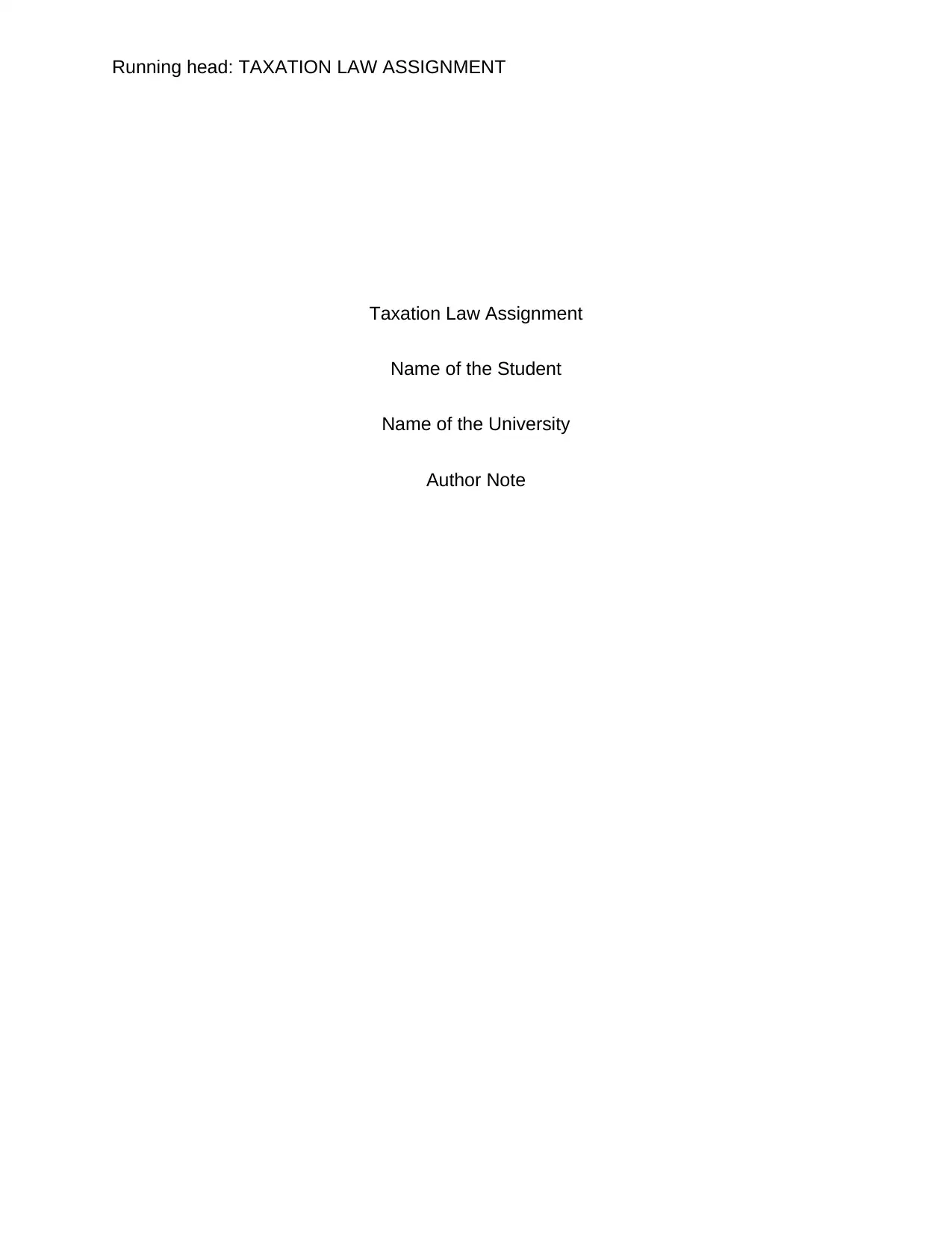
Running head: TAXATION LAW ASSIGNMENT
Taxation Law Assignment
Name of the Student
Name of the University
Author Note
Taxation Law Assignment
Name of the Student
Name of the University
Author Note
Paraphrase This Document
Need a fresh take? Get an instant paraphrase of this document with our AI Paraphraser
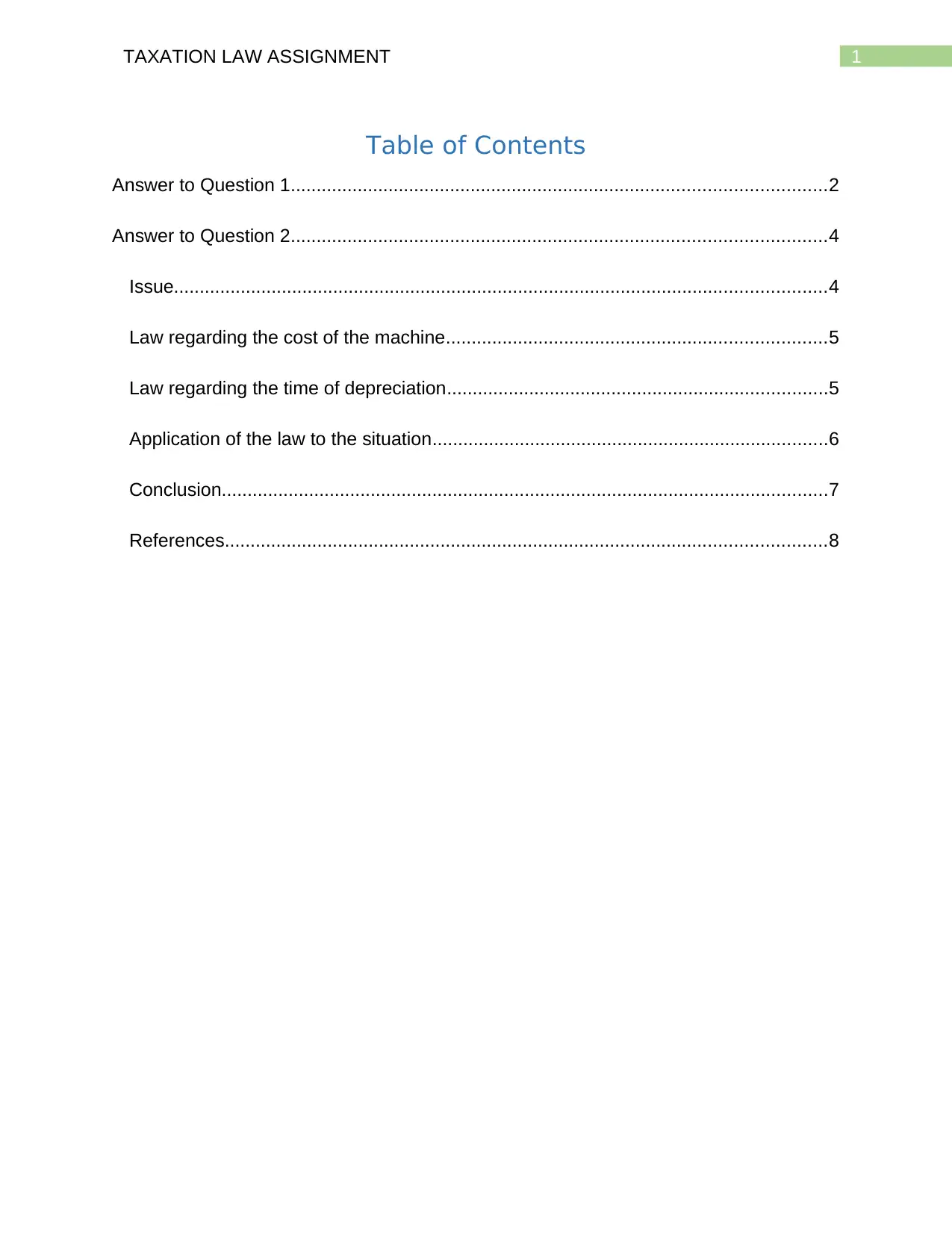
1TAXATION LAW ASSIGNMENT
Table of Contents
Answer to Question 1........................................................................................................2
Answer to Question 2........................................................................................................4
Issue...............................................................................................................................4
Law regarding the cost of the machine..........................................................................5
Law regarding the time of depreciation..........................................................................5
Application of the law to the situation.............................................................................6
Conclusion......................................................................................................................7
References.....................................................................................................................8
Table of Contents
Answer to Question 1........................................................................................................2
Answer to Question 2........................................................................................................4
Issue...............................................................................................................................4
Law regarding the cost of the machine..........................................................................5
Law regarding the time of depreciation..........................................................................5
Application of the law to the situation.............................................................................6
Conclusion......................................................................................................................7
References.....................................................................................................................8
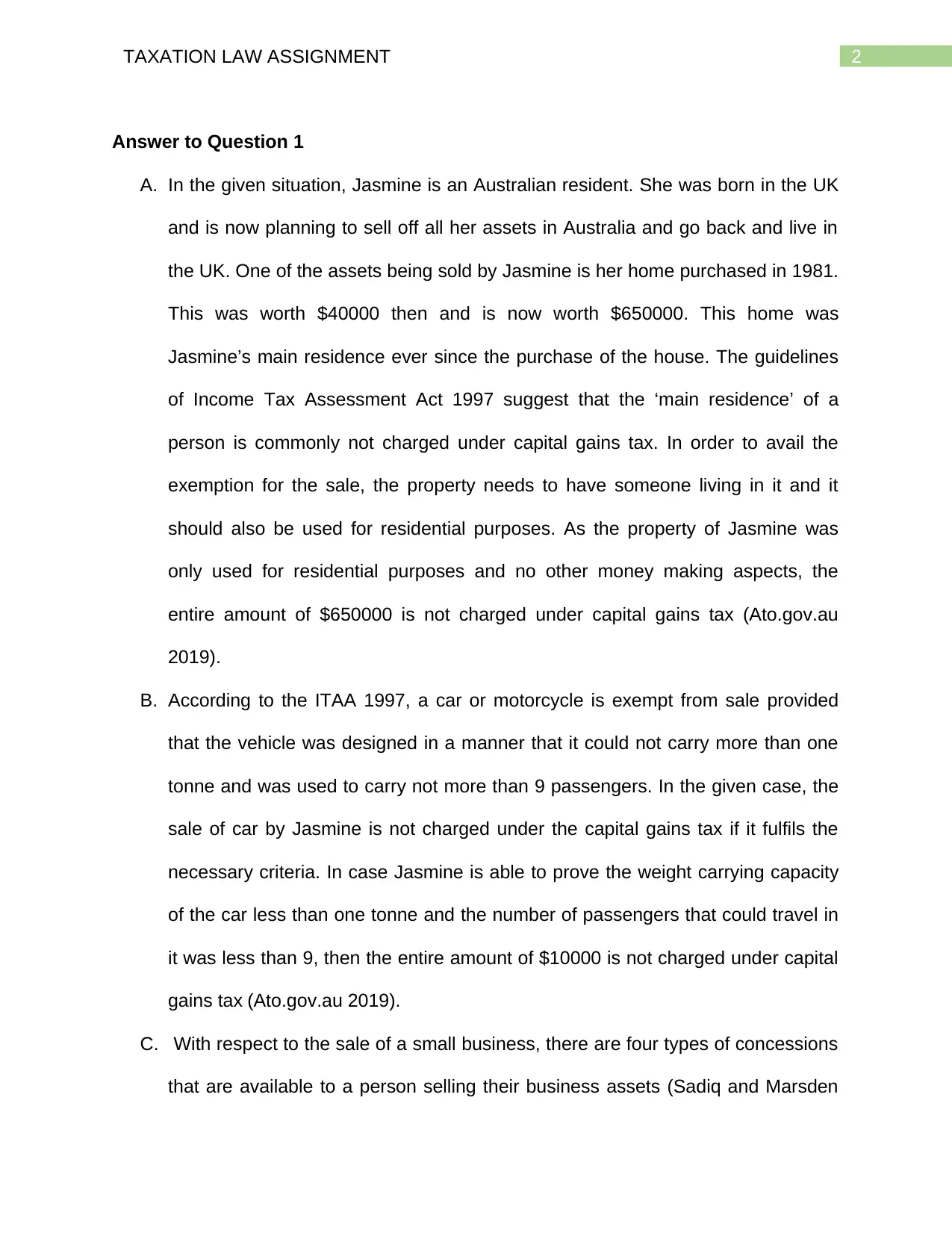
2TAXATION LAW ASSIGNMENT
Answer to Question 1
A. In the given situation, Jasmine is an Australian resident. She was born in the UK
and is now planning to sell off all her assets in Australia and go back and live in
the UK. One of the assets being sold by Jasmine is her home purchased in 1981.
This was worth $40000 then and is now worth $650000. This home was
Jasmine’s main residence ever since the purchase of the house. The guidelines
of Income Tax Assessment Act 1997 suggest that the ‘main residence’ of a
person is commonly not charged under capital gains tax. In order to avail the
exemption for the sale, the property needs to have someone living in it and it
should also be used for residential purposes. As the property of Jasmine was
only used for residential purposes and no other money making aspects, the
entire amount of $650000 is not charged under capital gains tax (Ato.gov.au
2019).
B. According to the ITAA 1997, a car or motorcycle is exempt from sale provided
that the vehicle was designed in a manner that it could not carry more than one
tonne and was used to carry not more than 9 passengers. In the given case, the
sale of car by Jasmine is not charged under the capital gains tax if it fulfils the
necessary criteria. In case Jasmine is able to prove the weight carrying capacity
of the car less than one tonne and the number of passengers that could travel in
it was less than 9, then the entire amount of $10000 is not charged under capital
gains tax (Ato.gov.au 2019).
C. With respect to the sale of a small business, there are four types of concessions
that are available to a person selling their business assets (Sadiq and Marsden
Answer to Question 1
A. In the given situation, Jasmine is an Australian resident. She was born in the UK
and is now planning to sell off all her assets in Australia and go back and live in
the UK. One of the assets being sold by Jasmine is her home purchased in 1981.
This was worth $40000 then and is now worth $650000. This home was
Jasmine’s main residence ever since the purchase of the house. The guidelines
of Income Tax Assessment Act 1997 suggest that the ‘main residence’ of a
person is commonly not charged under capital gains tax. In order to avail the
exemption for the sale, the property needs to have someone living in it and it
should also be used for residential purposes. As the property of Jasmine was
only used for residential purposes and no other money making aspects, the
entire amount of $650000 is not charged under capital gains tax (Ato.gov.au
2019).
B. According to the ITAA 1997, a car or motorcycle is exempt from sale provided
that the vehicle was designed in a manner that it could not carry more than one
tonne and was used to carry not more than 9 passengers. In the given case, the
sale of car by Jasmine is not charged under the capital gains tax if it fulfils the
necessary criteria. In case Jasmine is able to prove the weight carrying capacity
of the car less than one tonne and the number of passengers that could travel in
it was less than 9, then the entire amount of $10000 is not charged under capital
gains tax (Ato.gov.au 2019).
C. With respect to the sale of a small business, there are four types of concessions
that are available to a person selling their business assets (Sadiq and Marsden
⊘ This is a preview!⊘
Do you want full access?
Subscribe today to unlock all pages.

Trusted by 1+ million students worldwide
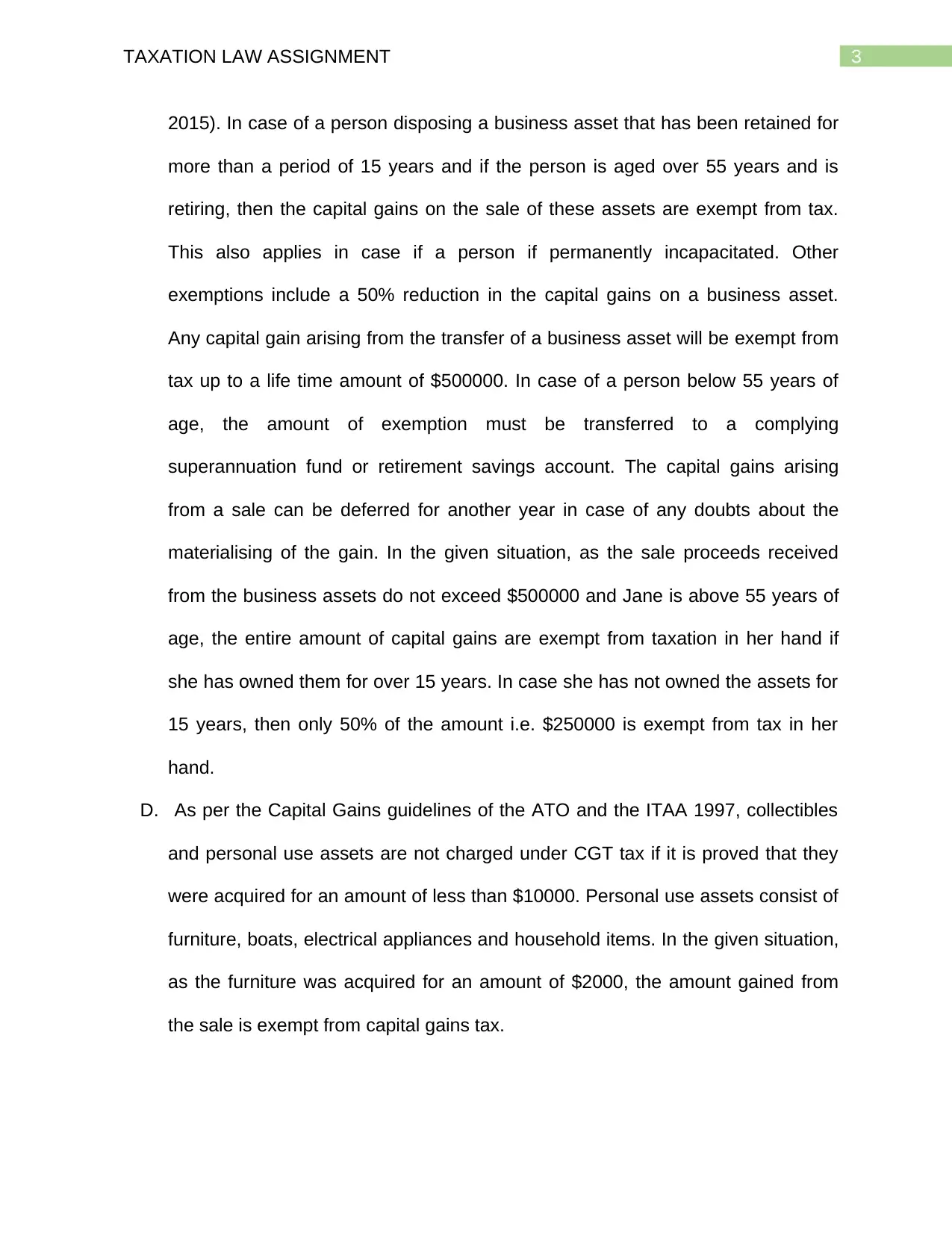
3TAXATION LAW ASSIGNMENT
2015). In case of a person disposing a business asset that has been retained for
more than a period of 15 years and if the person is aged over 55 years and is
retiring, then the capital gains on the sale of these assets are exempt from tax.
This also applies in case if a person if permanently incapacitated. Other
exemptions include a 50% reduction in the capital gains on a business asset.
Any capital gain arising from the transfer of a business asset will be exempt from
tax up to a life time amount of $500000. In case of a person below 55 years of
age, the amount of exemption must be transferred to a complying
superannuation fund or retirement savings account. The capital gains arising
from a sale can be deferred for another year in case of any doubts about the
materialising of the gain. In the given situation, as the sale proceeds received
from the business assets do not exceed $500000 and Jane is above 55 years of
age, the entire amount of capital gains are exempt from taxation in her hand if
she has owned them for over 15 years. In case she has not owned the assets for
15 years, then only 50% of the amount i.e. $250000 is exempt from tax in her
hand.
D. As per the Capital Gains guidelines of the ATO and the ITAA 1997, collectibles
and personal use assets are not charged under CGT tax if it is proved that they
were acquired for an amount of less than $10000. Personal use assets consist of
furniture, boats, electrical appliances and household items. In the given situation,
as the furniture was acquired for an amount of $2000, the amount gained from
the sale is exempt from capital gains tax.
2015). In case of a person disposing a business asset that has been retained for
more than a period of 15 years and if the person is aged over 55 years and is
retiring, then the capital gains on the sale of these assets are exempt from tax.
This also applies in case if a person if permanently incapacitated. Other
exemptions include a 50% reduction in the capital gains on a business asset.
Any capital gain arising from the transfer of a business asset will be exempt from
tax up to a life time amount of $500000. In case of a person below 55 years of
age, the amount of exemption must be transferred to a complying
superannuation fund or retirement savings account. The capital gains arising
from a sale can be deferred for another year in case of any doubts about the
materialising of the gain. In the given situation, as the sale proceeds received
from the business assets do not exceed $500000 and Jane is above 55 years of
age, the entire amount of capital gains are exempt from taxation in her hand if
she has owned them for over 15 years. In case she has not owned the assets for
15 years, then only 50% of the amount i.e. $250000 is exempt from tax in her
hand.
D. As per the Capital Gains guidelines of the ATO and the ITAA 1997, collectibles
and personal use assets are not charged under CGT tax if it is proved that they
were acquired for an amount of less than $10000. Personal use assets consist of
furniture, boats, electrical appliances and household items. In the given situation,
as the furniture was acquired for an amount of $2000, the amount gained from
the sale is exempt from capital gains tax.
Paraphrase This Document
Need a fresh take? Get an instant paraphrase of this document with our AI Paraphraser
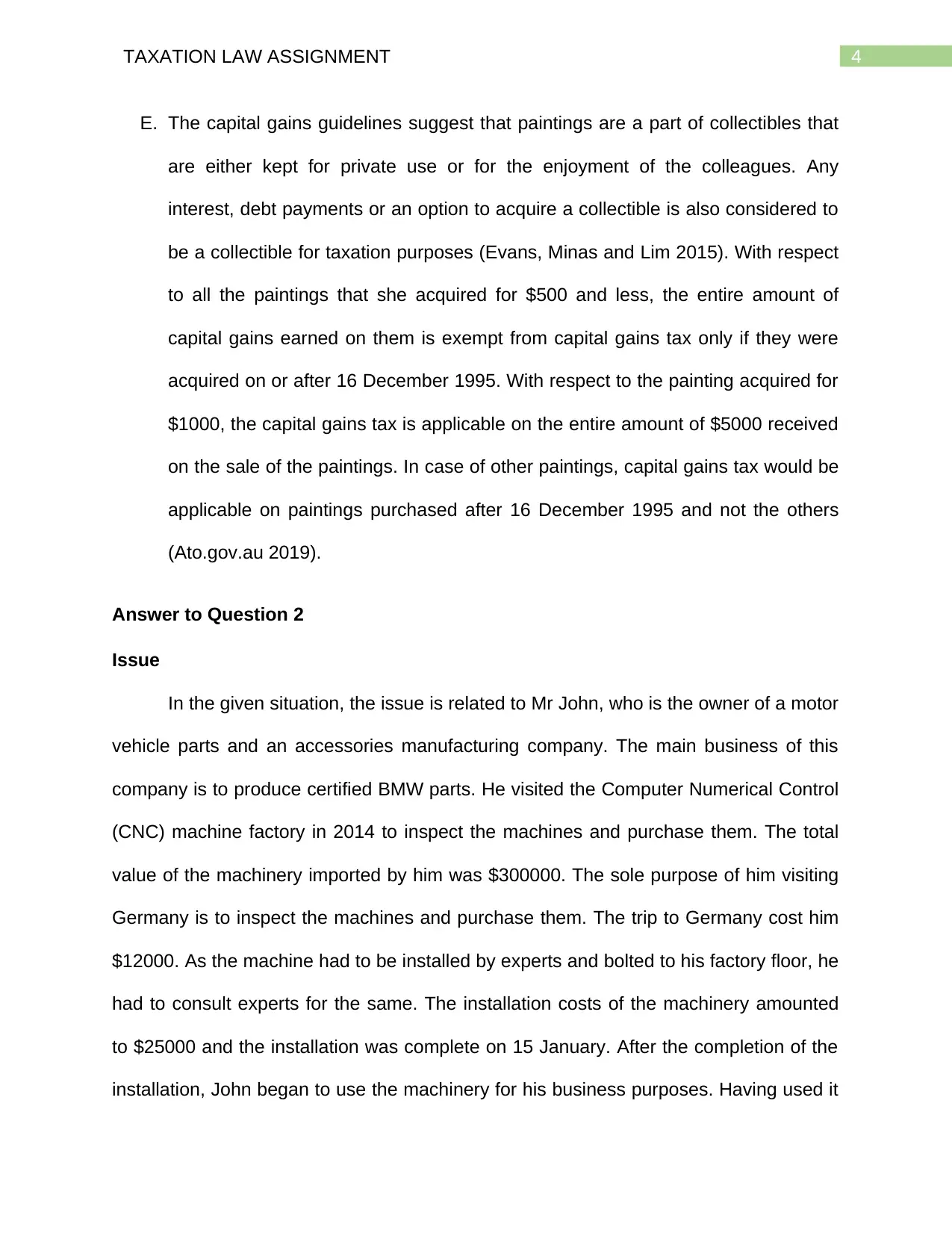
4TAXATION LAW ASSIGNMENT
E. The capital gains guidelines suggest that paintings are a part of collectibles that
are either kept for private use or for the enjoyment of the colleagues. Any
interest, debt payments or an option to acquire a collectible is also considered to
be a collectible for taxation purposes (Evans, Minas and Lim 2015). With respect
to all the paintings that she acquired for $500 and less, the entire amount of
capital gains earned on them is exempt from capital gains tax only if they were
acquired on or after 16 December 1995. With respect to the painting acquired for
$1000, the capital gains tax is applicable on the entire amount of $5000 received
on the sale of the paintings. In case of other paintings, capital gains tax would be
applicable on paintings purchased after 16 December 1995 and not the others
(Ato.gov.au 2019).
Answer to Question 2
Issue
In the given situation, the issue is related to Mr John, who is the owner of a motor
vehicle parts and an accessories manufacturing company. The main business of this
company is to produce certified BMW parts. He visited the Computer Numerical Control
(CNC) machine factory in 2014 to inspect the machines and purchase them. The total
value of the machinery imported by him was $300000. The sole purpose of him visiting
Germany is to inspect the machines and purchase them. The trip to Germany cost him
$12000. As the machine had to be installed by experts and bolted to his factory floor, he
had to consult experts for the same. The installation costs of the machinery amounted
to $25000 and the installation was complete on 15 January. After the completion of the
installation, John began to use the machinery for his business purposes. Having used it
E. The capital gains guidelines suggest that paintings are a part of collectibles that
are either kept for private use or for the enjoyment of the colleagues. Any
interest, debt payments or an option to acquire a collectible is also considered to
be a collectible for taxation purposes (Evans, Minas and Lim 2015). With respect
to all the paintings that she acquired for $500 and less, the entire amount of
capital gains earned on them is exempt from capital gains tax only if they were
acquired on or after 16 December 1995. With respect to the painting acquired for
$1000, the capital gains tax is applicable on the entire amount of $5000 received
on the sale of the paintings. In case of other paintings, capital gains tax would be
applicable on paintings purchased after 16 December 1995 and not the others
(Ato.gov.au 2019).
Answer to Question 2
Issue
In the given situation, the issue is related to Mr John, who is the owner of a motor
vehicle parts and an accessories manufacturing company. The main business of this
company is to produce certified BMW parts. He visited the Computer Numerical Control
(CNC) machine factory in 2014 to inspect the machines and purchase them. The total
value of the machinery imported by him was $300000. The sole purpose of him visiting
Germany is to inspect the machines and purchase them. The trip to Germany cost him
$12000. As the machine had to be installed by experts and bolted to his factory floor, he
had to consult experts for the same. The installation costs of the machinery amounted
to $25000 and the installation was complete on 15 January. After the completion of the
installation, John began to use the machinery for his business purposes. Having used it
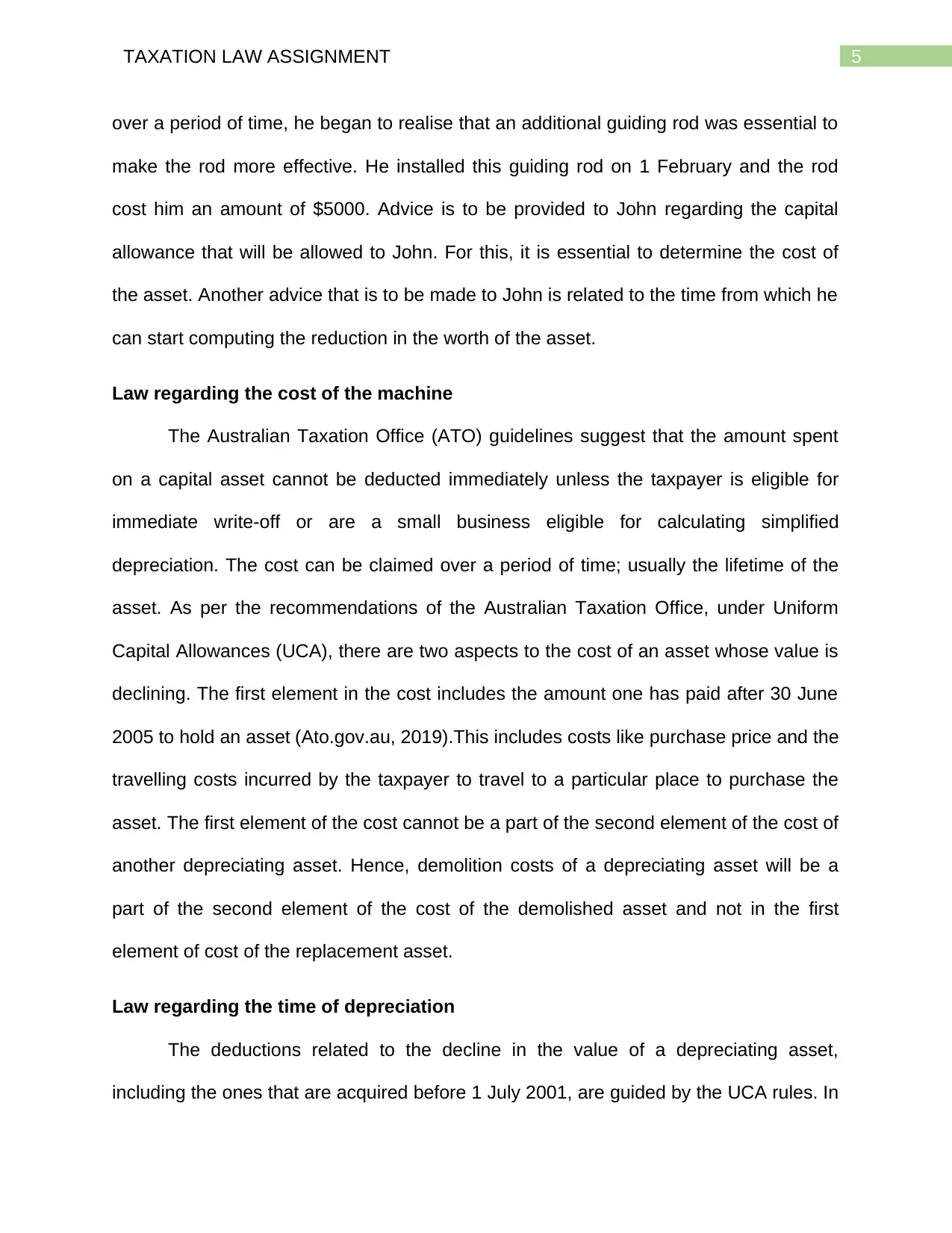
5TAXATION LAW ASSIGNMENT
over a period of time, he began to realise that an additional guiding rod was essential to
make the rod more effective. He installed this guiding rod on 1 February and the rod
cost him an amount of $5000. Advice is to be provided to John regarding the capital
allowance that will be allowed to John. For this, it is essential to determine the cost of
the asset. Another advice that is to be made to John is related to the time from which he
can start computing the reduction in the worth of the asset.
Law regarding the cost of the machine
The Australian Taxation Office (ATO) guidelines suggest that the amount spent
on a capital asset cannot be deducted immediately unless the taxpayer is eligible for
immediate write-off or are a small business eligible for calculating simplified
depreciation. The cost can be claimed over a period of time; usually the lifetime of the
asset. As per the recommendations of the Australian Taxation Office, under Uniform
Capital Allowances (UCA), there are two aspects to the cost of an asset whose value is
declining. The first element in the cost includes the amount one has paid after 30 June
2005 to hold an asset (Ato.gov.au, 2019).This includes costs like purchase price and the
travelling costs incurred by the taxpayer to travel to a particular place to purchase the
asset. The first element of the cost cannot be a part of the second element of the cost of
another depreciating asset. Hence, demolition costs of a depreciating asset will be a
part of the second element of the cost of the demolished asset and not in the first
element of cost of the replacement asset.
Law regarding the time of depreciation
The deductions related to the decline in the value of a depreciating asset,
including the ones that are acquired before 1 July 2001, are guided by the UCA rules. In
over a period of time, he began to realise that an additional guiding rod was essential to
make the rod more effective. He installed this guiding rod on 1 February and the rod
cost him an amount of $5000. Advice is to be provided to John regarding the capital
allowance that will be allowed to John. For this, it is essential to determine the cost of
the asset. Another advice that is to be made to John is related to the time from which he
can start computing the reduction in the worth of the asset.
Law regarding the cost of the machine
The Australian Taxation Office (ATO) guidelines suggest that the amount spent
on a capital asset cannot be deducted immediately unless the taxpayer is eligible for
immediate write-off or are a small business eligible for calculating simplified
depreciation. The cost can be claimed over a period of time; usually the lifetime of the
asset. As per the recommendations of the Australian Taxation Office, under Uniform
Capital Allowances (UCA), there are two aspects to the cost of an asset whose value is
declining. The first element in the cost includes the amount one has paid after 30 June
2005 to hold an asset (Ato.gov.au, 2019).This includes costs like purchase price and the
travelling costs incurred by the taxpayer to travel to a particular place to purchase the
asset. The first element of the cost cannot be a part of the second element of the cost of
another depreciating asset. Hence, demolition costs of a depreciating asset will be a
part of the second element of the cost of the demolished asset and not in the first
element of cost of the replacement asset.
Law regarding the time of depreciation
The deductions related to the decline in the value of a depreciating asset,
including the ones that are acquired before 1 July 2001, are guided by the UCA rules. In
⊘ This is a preview!⊘
Do you want full access?
Subscribe today to unlock all pages.

Trusted by 1+ million students worldwide
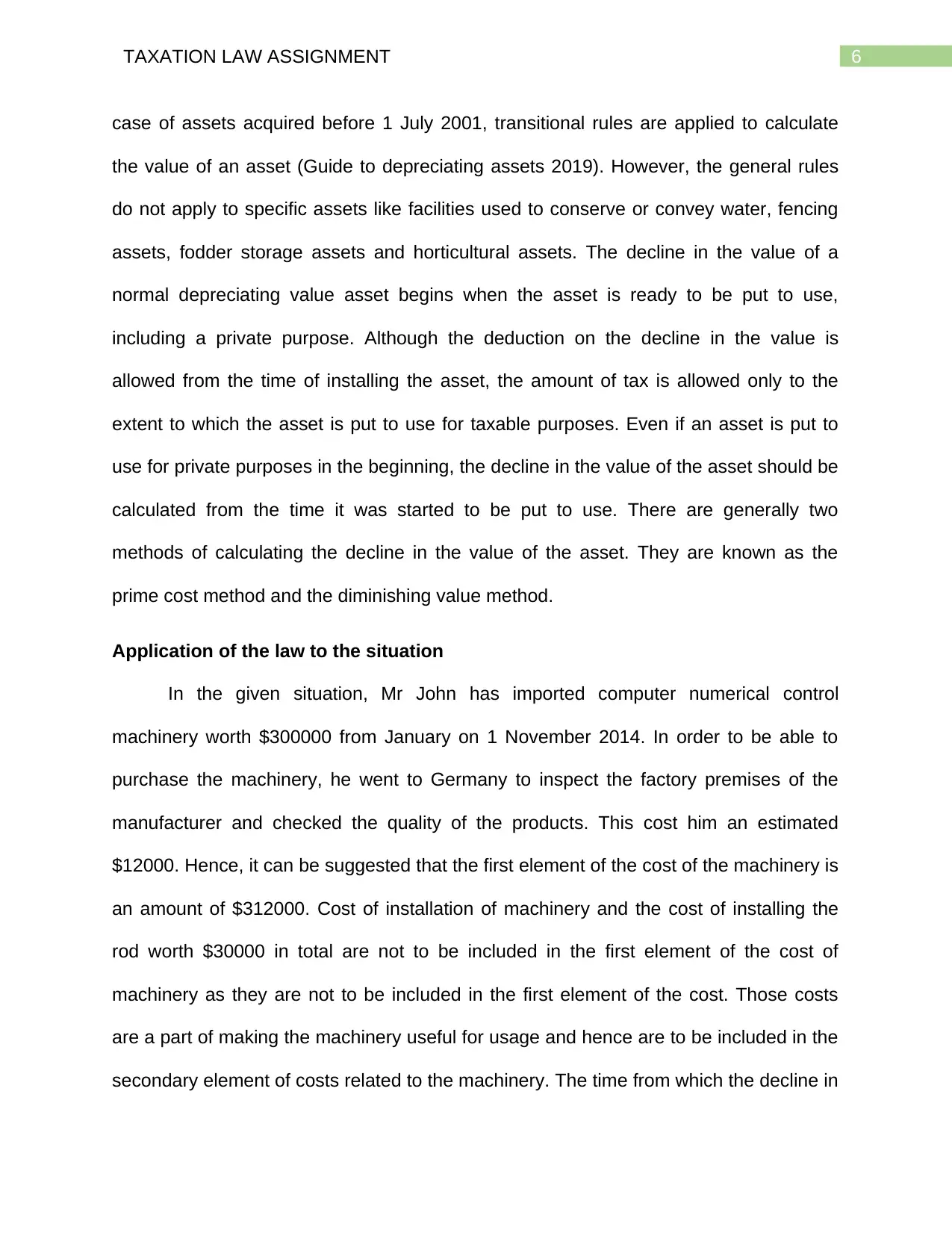
6TAXATION LAW ASSIGNMENT
case of assets acquired before 1 July 2001, transitional rules are applied to calculate
the value of an asset (Guide to depreciating assets 2019). However, the general rules
do not apply to specific assets like facilities used to conserve or convey water, fencing
assets, fodder storage assets and horticultural assets. The decline in the value of a
normal depreciating value asset begins when the asset is ready to be put to use,
including a private purpose. Although the deduction on the decline in the value is
allowed from the time of installing the asset, the amount of tax is allowed only to the
extent to which the asset is put to use for taxable purposes. Even if an asset is put to
use for private purposes in the beginning, the decline in the value of the asset should be
calculated from the time it was started to be put to use. There are generally two
methods of calculating the decline in the value of the asset. They are known as the
prime cost method and the diminishing value method.
Application of the law to the situation
In the given situation, Mr John has imported computer numerical control
machinery worth $300000 from January on 1 November 2014. In order to be able to
purchase the machinery, he went to Germany to inspect the factory premises of the
manufacturer and checked the quality of the products. This cost him an estimated
$12000. Hence, it can be suggested that the first element of the cost of the machinery is
an amount of $312000. Cost of installation of machinery and the cost of installing the
rod worth $30000 in total are not to be included in the first element of the cost of
machinery as they are not to be included in the first element of the cost. Those costs
are a part of making the machinery useful for usage and hence are to be included in the
secondary element of costs related to the machinery. The time from which the decline in
case of assets acquired before 1 July 2001, transitional rules are applied to calculate
the value of an asset (Guide to depreciating assets 2019). However, the general rules
do not apply to specific assets like facilities used to conserve or convey water, fencing
assets, fodder storage assets and horticultural assets. The decline in the value of a
normal depreciating value asset begins when the asset is ready to be put to use,
including a private purpose. Although the deduction on the decline in the value is
allowed from the time of installing the asset, the amount of tax is allowed only to the
extent to which the asset is put to use for taxable purposes. Even if an asset is put to
use for private purposes in the beginning, the decline in the value of the asset should be
calculated from the time it was started to be put to use. There are generally two
methods of calculating the decline in the value of the asset. They are known as the
prime cost method and the diminishing value method.
Application of the law to the situation
In the given situation, Mr John has imported computer numerical control
machinery worth $300000 from January on 1 November 2014. In order to be able to
purchase the machinery, he went to Germany to inspect the factory premises of the
manufacturer and checked the quality of the products. This cost him an estimated
$12000. Hence, it can be suggested that the first element of the cost of the machinery is
an amount of $312000. Cost of installation of machinery and the cost of installing the
rod worth $30000 in total are not to be included in the first element of the cost of
machinery as they are not to be included in the first element of the cost. Those costs
are a part of making the machinery useful for usage and hence are to be included in the
secondary element of costs related to the machinery. The time from which the decline in
Paraphrase This Document
Need a fresh take? Get an instant paraphrase of this document with our AI Paraphraser
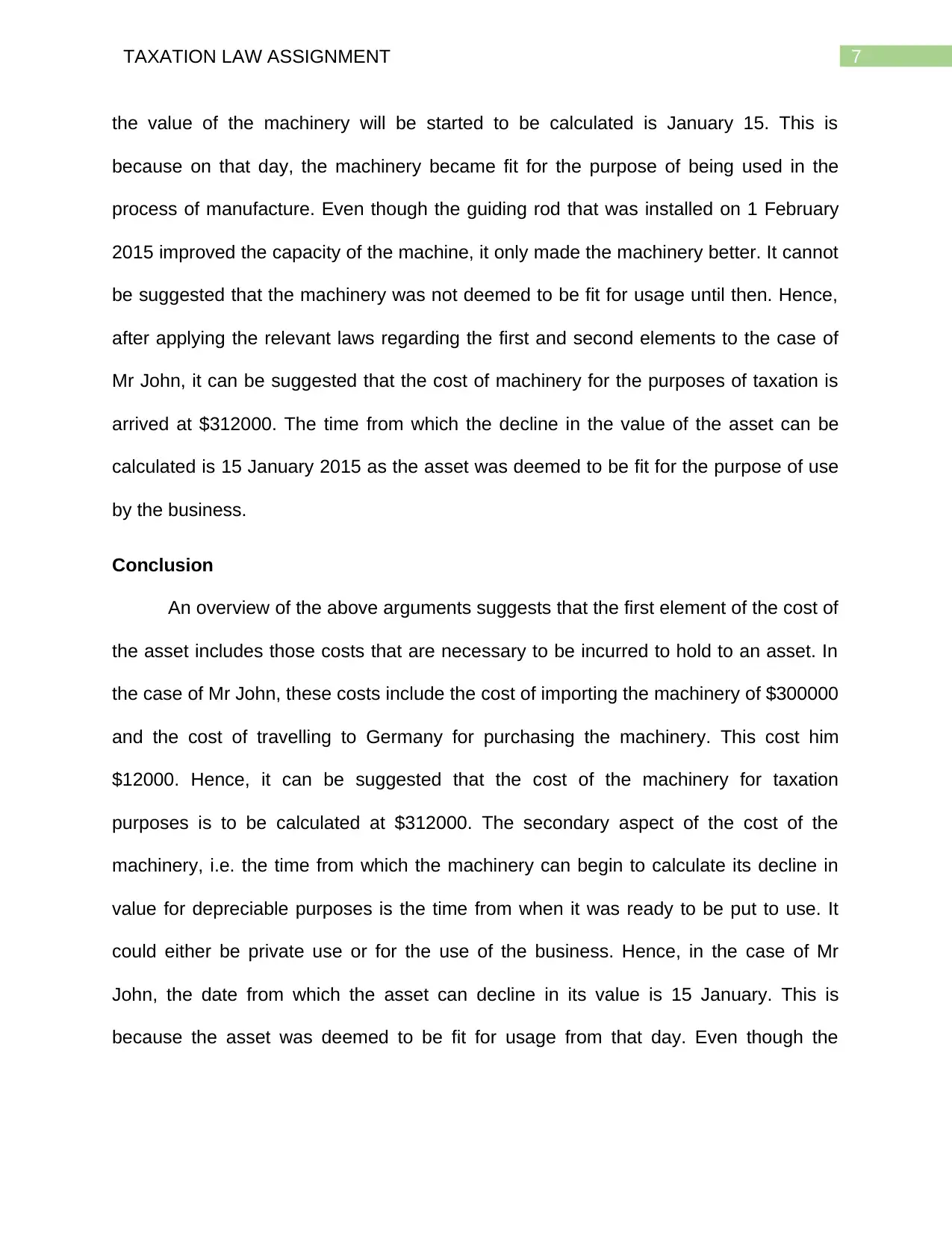
7TAXATION LAW ASSIGNMENT
the value of the machinery will be started to be calculated is January 15. This is
because on that day, the machinery became fit for the purpose of being used in the
process of manufacture. Even though the guiding rod that was installed on 1 February
2015 improved the capacity of the machine, it only made the machinery better. It cannot
be suggested that the machinery was not deemed to be fit for usage until then. Hence,
after applying the relevant laws regarding the first and second elements to the case of
Mr John, it can be suggested that the cost of machinery for the purposes of taxation is
arrived at $312000. The time from which the decline in the value of the asset can be
calculated is 15 January 2015 as the asset was deemed to be fit for the purpose of use
by the business.
Conclusion
An overview of the above arguments suggests that the first element of the cost of
the asset includes those costs that are necessary to be incurred to hold to an asset. In
the case of Mr John, these costs include the cost of importing the machinery of $300000
and the cost of travelling to Germany for purchasing the machinery. This cost him
$12000. Hence, it can be suggested that the cost of the machinery for taxation
purposes is to be calculated at $312000. The secondary aspect of the cost of the
machinery, i.e. the time from which the machinery can begin to calculate its decline in
value for depreciable purposes is the time from when it was ready to be put to use. It
could either be private use or for the use of the business. Hence, in the case of Mr
John, the date from which the asset can decline in its value is 15 January. This is
because the asset was deemed to be fit for usage from that day. Even though the
the value of the machinery will be started to be calculated is January 15. This is
because on that day, the machinery became fit for the purpose of being used in the
process of manufacture. Even though the guiding rod that was installed on 1 February
2015 improved the capacity of the machine, it only made the machinery better. It cannot
be suggested that the machinery was not deemed to be fit for usage until then. Hence,
after applying the relevant laws regarding the first and second elements to the case of
Mr John, it can be suggested that the cost of machinery for the purposes of taxation is
arrived at $312000. The time from which the decline in the value of the asset can be
calculated is 15 January 2015 as the asset was deemed to be fit for the purpose of use
by the business.
Conclusion
An overview of the above arguments suggests that the first element of the cost of
the asset includes those costs that are necessary to be incurred to hold to an asset. In
the case of Mr John, these costs include the cost of importing the machinery of $300000
and the cost of travelling to Germany for purchasing the machinery. This cost him
$12000. Hence, it can be suggested that the cost of the machinery for taxation
purposes is to be calculated at $312000. The secondary aspect of the cost of the
machinery, i.e. the time from which the machinery can begin to calculate its decline in
value for depreciable purposes is the time from when it was ready to be put to use. It
could either be private use or for the use of the business. Hence, in the case of Mr
John, the date from which the asset can decline in its value is 15 January. This is
because the asset was deemed to be fit for usage from that day. Even though the
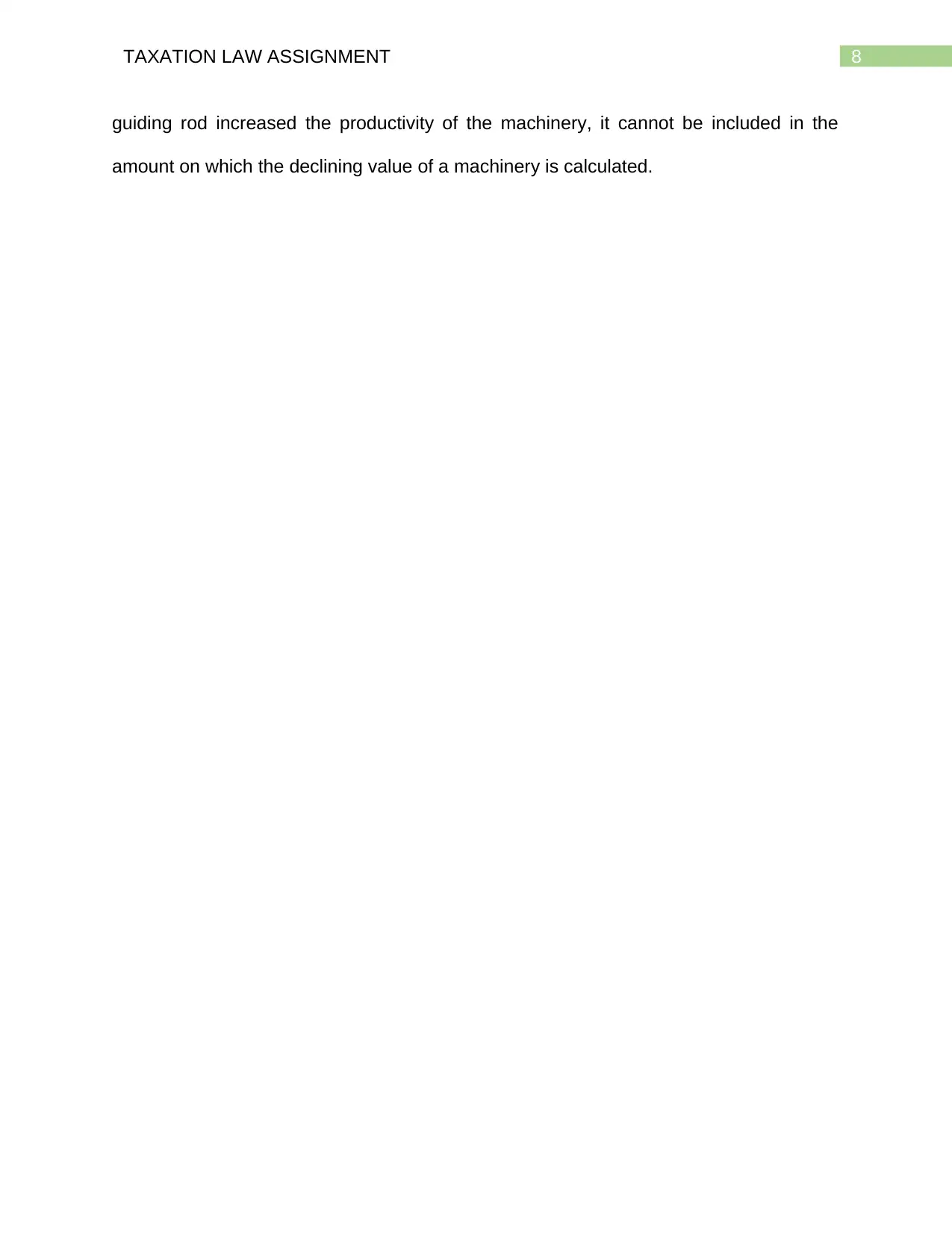
8TAXATION LAW ASSIGNMENT
guiding rod increased the productivity of the machinery, it cannot be included in the
amount on which the declining value of a machinery is calculated.
guiding rod increased the productivity of the machinery, it cannot be included in the
amount on which the declining value of a machinery is calculated.
⊘ This is a preview!⊘
Do you want full access?
Subscribe today to unlock all pages.

Trusted by 1+ million students worldwide
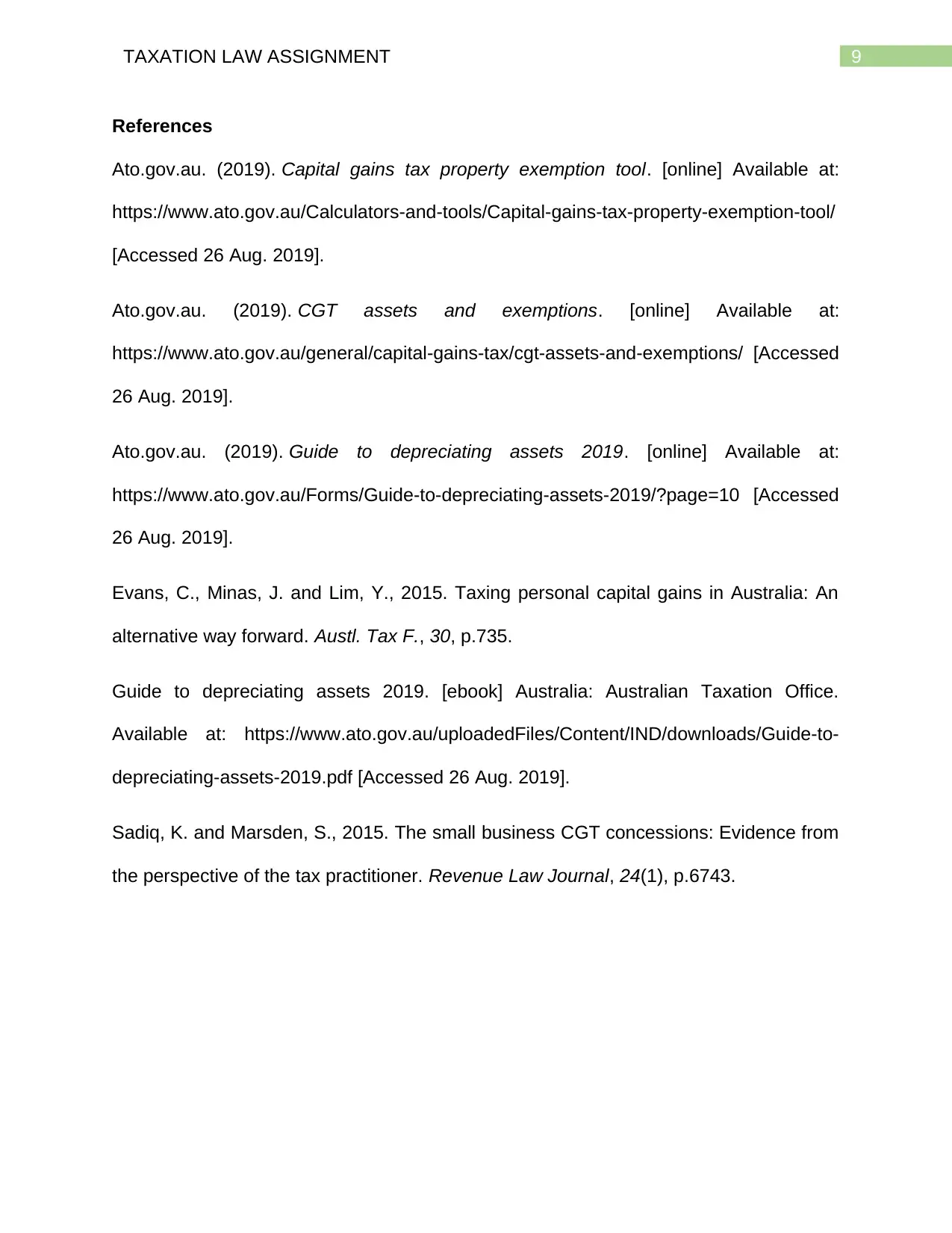
9TAXATION LAW ASSIGNMENT
References
Ato.gov.au. (2019). Capital gains tax property exemption tool. [online] Available at:
https://www.ato.gov.au/Calculators-and-tools/Capital-gains-tax-property-exemption-tool/
[Accessed 26 Aug. 2019].
Ato.gov.au. (2019). CGT assets and exemptions. [online] Available at:
https://www.ato.gov.au/general/capital-gains-tax/cgt-assets-and-exemptions/ [Accessed
26 Aug. 2019].
Ato.gov.au. (2019). Guide to depreciating assets 2019. [online] Available at:
https://www.ato.gov.au/Forms/Guide-to-depreciating-assets-2019/?page=10 [Accessed
26 Aug. 2019].
Evans, C., Minas, J. and Lim, Y., 2015. Taxing personal capital gains in Australia: An
alternative way forward. Austl. Tax F., 30, p.735.
Guide to depreciating assets 2019. [ebook] Australia: Australian Taxation Office.
Available at: https://www.ato.gov.au/uploadedFiles/Content/IND/downloads/Guide-to-
depreciating-assets-2019.pdf [Accessed 26 Aug. 2019].
Sadiq, K. and Marsden, S., 2015. The small business CGT concessions: Evidence from
the perspective of the tax practitioner. Revenue Law Journal, 24(1), p.6743.
References
Ato.gov.au. (2019). Capital gains tax property exemption tool. [online] Available at:
https://www.ato.gov.au/Calculators-and-tools/Capital-gains-tax-property-exemption-tool/
[Accessed 26 Aug. 2019].
Ato.gov.au. (2019). CGT assets and exemptions. [online] Available at:
https://www.ato.gov.au/general/capital-gains-tax/cgt-assets-and-exemptions/ [Accessed
26 Aug. 2019].
Ato.gov.au. (2019). Guide to depreciating assets 2019. [online] Available at:
https://www.ato.gov.au/Forms/Guide-to-depreciating-assets-2019/?page=10 [Accessed
26 Aug. 2019].
Evans, C., Minas, J. and Lim, Y., 2015. Taxing personal capital gains in Australia: An
alternative way forward. Austl. Tax F., 30, p.735.
Guide to depreciating assets 2019. [ebook] Australia: Australian Taxation Office.
Available at: https://www.ato.gov.au/uploadedFiles/Content/IND/downloads/Guide-to-
depreciating-assets-2019.pdf [Accessed 26 Aug. 2019].
Sadiq, K. and Marsden, S., 2015. The small business CGT concessions: Evidence from
the perspective of the tax practitioner. Revenue Law Journal, 24(1), p.6743.
1 out of 10
Related Documents
Your All-in-One AI-Powered Toolkit for Academic Success.
+13062052269
info@desklib.com
Available 24*7 on WhatsApp / Email
![[object Object]](/_next/static/media/star-bottom.7253800d.svg)
Unlock your academic potential
Copyright © 2020–2025 A2Z Services. All Rights Reserved. Developed and managed by ZUCOL.





